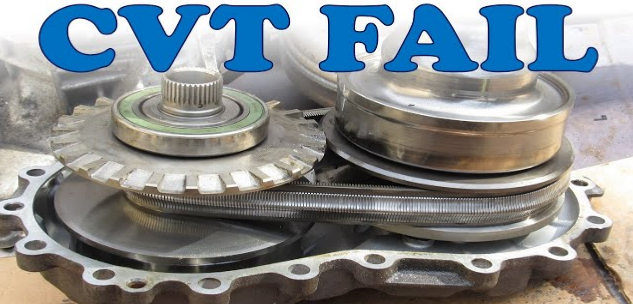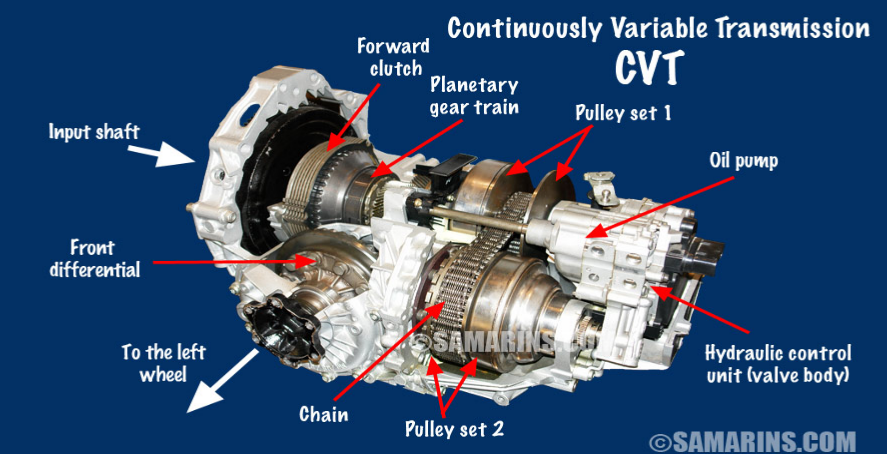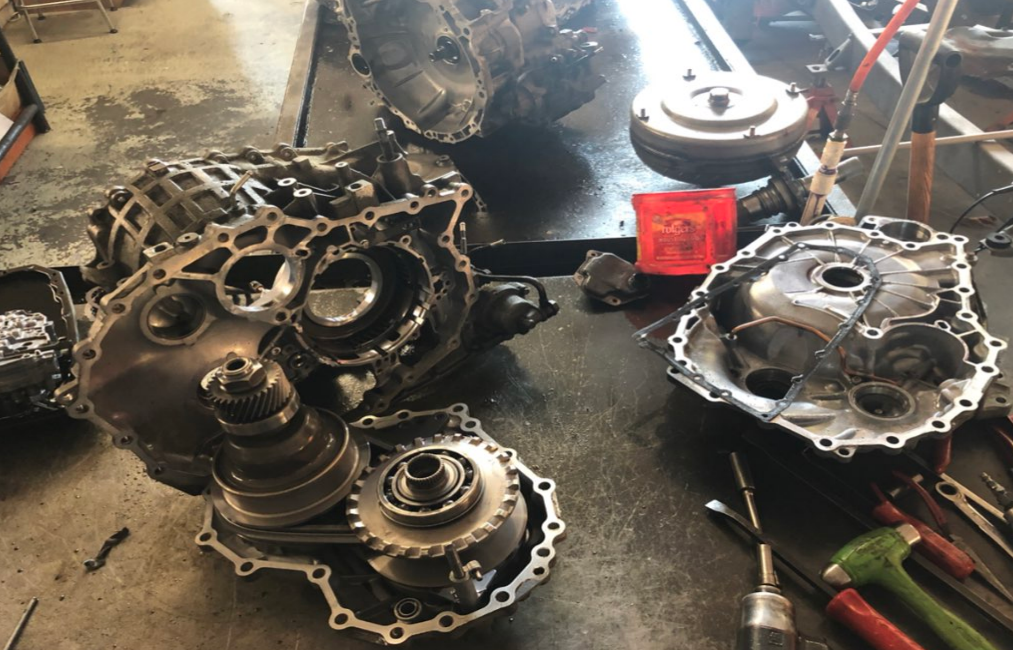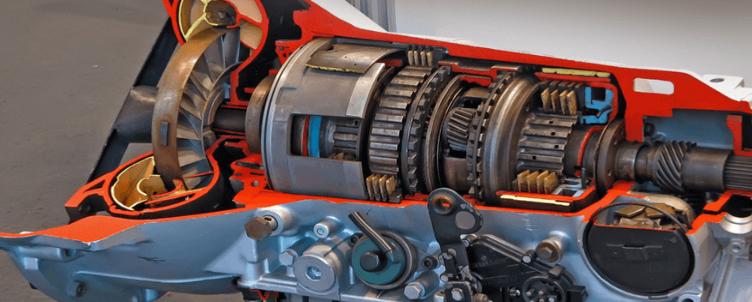Nissan CVT has advanced over years, offering smooth driving and fuel efficiency, but early models faced reliability issues.
Introduction
Brief overview of CVT (Continuously Variable Transmission)
The Continuously Variable Transmission, commonly referred to as CVT, is a unique type of automatic transmission that provides seamless acceleration without any noticeable gear shifts. Instead of relying on a set number of gears, a CVT uses a belt or chain running between two pulleys to offer a wide range of gear ratios. This characteristic ensures a more responsive and smoother driving experience, especially during rapid acceleration or deceleration. One of the primary advantages of the CVT is its efficiency. Compared to traditional transmissions, CVTs can boost fuel efficiency by up to 10%, translating to notable savings on fuel costs. However, there’s also a debate about its long-term durability and repair costs, which can be higher than conventional transmissions.

Nissan’s adoption of CVT technology
Nissan, a Japanese automaker with a rich history of innovation, embraced the CVT technology in the early 2000s. The company viewed it as a pivotal solution to improve fuel efficiency without compromising performance. By 2007, Nissan had introduced CVT in most of its sedan models, with notable inclusions being the Altima and the Maxima. This move was part of Nissan’s strategy to reduce carbon emissions and meet stringent fuel efficiency standards worldwide.
Given the fuel prices around 2007 averaging $3.25 per gallon and the average person driving approximately 12,000 miles annually, a 10% improvement in fuel efficiency could lead to savings of around $117 per year for a typical sedan. However, with innovation came challenges. Some early adopters reported concerns about the CVT’s responsiveness and a different feel compared to traditional transmissions. Additionally, initial models faced issues with durability, with some transmissions needing replacements just after 60,000 miles. This raised questions about the long-term value of adopting a CVT. Over time, Nissan invested heavily in research and development, fine-tuning their CVT technology to address these concerns. As of 2022, the technology has matured, and most concerns have been addressed, but debates about its pros and cons persist.
History of Nissan’s CVT
Evolution of Nissan’s CVT over the years
The journey of Nissan’s Continuously Variable Transmission began in earnest during the late 1990s. With the automotive world transitioning to more efficient and eco-friendly technologies, Nissan saw the potential of CVTs in revolutionizing the traditional gearbox landscape. Their first large-scale adoption was in the 2002 Nissan Murano, a mid-size crossover SUV. The Murano’s CVT offered drivers a fuel efficiency advantage of about 5% over traditional gearboxes, representing a potential annual savings of $60, given the average gas prices and yearly driving habits of that time.
However, it wasn’t always a smooth ride. Early versions of Nissan’s CVT, particularly those in the 2003-2010 models, faced durability challenges. There were reports of these transmissions failing around the 100,000-mile mark, way below the average lifespan expected from modern transmissions. In response, Nissan initiated upgrades in subsequent models. By 2013, after extensive research and development, Nissan introduced a more robust CVT in their vehicles, which boasted not only better durability but also improved fuel efficiency by an additional 5%.
Milestones and innovations introduced
Nissan’s dedication to perfecting the CVT led to several milestones and innovations in the automotive world:
- 2002: Introduction of the CVT in the Nissan Murano, representing Nissan’s commitment to this technology.
- 2007: Nissan rolled out the CVT to a broader range of models, including the popular Altima and Sentra. This move came with an efficiency improvement, which meant models like the Altima now achieved an impressive 32 miles per gallon on the highway, a significant achievement for a non-hybrid mid-size sedan of that era.
- 2010: Nissan addressed some of the CVT’s responsiveness concerns by introducing “D-Step Logic Control” in their transmissions. This innovation simulated gear changes, giving drivers a feel similar to traditional transmissions, especially during rapid accelerations.
- 2013: A significant year for Nissan’s CVT. The company released a more compact and lightweight version, which further improved fuel efficiency. This new design also came with a 60% reduction in friction, resulting in smoother operations and a longer lifespan. The efficiency gains translated to potential savings of $90 annually, considering the average gas prices and driving patterns.
Through these milestones, Nissan firmly established itself as a pioneer in CVT technology, continuously pushing boundaries and setting new standards in transmission efficiency and innovation.

Advantages of Nissan’s CVT
Fuel efficiency benefits
One of the standout advantages of Nissan’s CVT is the marked improvement in fuel efficiency. Traditional automatic transmissions rely on fixed gear ratios, which can sometimes lead to the engine working harder than necessary, burning more fuel. In contrast, the CVT seamlessly changes its gear ratios in real-time, allowing the engine to operate at its most efficient RPM (revolutions per minute) for a given speed. For instance, the 2022 Nissan Altima, equipped with a CVT, achieves an impressive 28 miles per gallon in the city and 39 miles per gallon on the highway. Given the average driving conditions and gas prices in 2022, this could lead to annual savings of up to $150 for an average driver compared to other mid-size sedans with traditional transmissions.
Smooth driving experience
Unlike traditional transmissions that shift through gears, CVTs provide a buttery-smooth acceleration experience. This absence of noticeable gear shifts means drivers won’t feel the common jerk or pause during acceleration, making for a more pleasant driving experience. For instance, when merging onto a highway or overtaking another vehicle, the CVT in the Nissan Maxima provides uninterrupted power delivery, allowing for swift and seamless acceleration, reaching 0-60 mph in just 5.8 seconds.
Adaptability to various driving conditions
A key strength of the CVT lies in its ability to adapt to various driving scenarios. Whether it’s navigating city traffic, cruising on the highway, or climbing steep terrains, the CVT can instantaneously adjust to provide the optimal gear ratio. This adaptability is particularly beneficial in conditions like hill starts, where the CVT ensures that the vehicle doesn’t roll backward. Moreover, in models like the Nissan Pathfinder, the CVT pairs exceptionally well with the vehicle’s 4×4 capabilities, providing optimal power distribution and ensuring that the vehicle maintains grip even in challenging off-road conditions.
Through these advantages, Nissan’s CVT offers drivers a blend of efficiency, comfort, and versatility, making it a compelling choice for those seeking a balanced driving experience.
Criticism and Concerns
Common problems reported by users
While Nissan’s CVT offers several advantages, it hasn’t been without its share of criticisms. Some of the initial models, especially between 2003 and 2010, faced a series of issues. One prevalent complaint centered around the “rubber band” effect, where drivers felt a lag or stretch in power delivery, similar to the sensation of stretching a rubber band before it snaps back. This experience, unfamiliar to many used to traditional transmissions, led to reports of unsatisfactory acceleration and a general feeling of power loss.
Another common problem highlighted by users was the overheating of the CVT, especially during extended drives or in heavy traffic conditions. Overheating could lead to the vehicle entering a fail-safe mode, where power delivery gets limited to prevent damage, often leaving drivers with significantly reduced acceleration until the transmission cooled down. This issue was particularly problematic in regions with warmer climates.
Longevity and reliability issues
One of the major concerns raised about Nissan’s CVT was its longevity and reliability. Several users reported failures or significant issues well before reaching the 100,000-mile mark. In some cases, transmissions needed replacements around 60,000 miles. These replacements weren’t cheap either, with costs often ranging between $3,500 to $5,000, a significant expense for owners. While Nissan did address many of these concerns in later models, the early issues did impact the CVT’s reputation for durability.
Comparisons with traditional automatic transmissions
When comparing to traditional automatic transmissions, several criticisms emerge:
- Feel and Responsiveness: Traditional transmissions offer a certain feel during gear shifts, which many drivers appreciate. In contrast, CVTs, especially the earlier Nissan models, lacked this tactile feedback, leading some drivers to feel disconnected from the driving experience.
- Repair Costs: While both CVTs and traditional transmissions can be expensive to repair, the CVT’s complexity can sometimes lead to higher repair bills. A traditional transmission might cost around $2,500 to $3,000 to replace, while CVT replacements could be higher, sometimes reaching $5,000.
- Performance: Traditional automatics, especially those with dual-clutch systems, can offer faster shift times, benefiting acceleration and performance driving. While Nissan’s CVT provides smooth power delivery, some driving enthusiasts prefer the immediate response and feedback from traditional systems.
In conclusion, while Nissan’s CVT has its merits, it’s essential for potential buyers to be aware of these criticisms and concerns, ensuring they make an informed decision based on their driving needs and preferences.
Maintenance and Care
Recommended maintenance practices for Nissan CVT
Regular maintenance is paramount to ensure the longevity and optimal performance of the CVT:
- CVT Fluid Changes: Unlike traditional transmissions that require oil changes, CVTs need specific transmission fluid changes. Nissan recommends changing the CVT fluid every 60,000 miles or every 4 years, whichever comes first. Using the specific fluid recommended by Nissan is crucial, as using non-specified fluids can lead to reduced performance and potential damage.
- Avoid Overloading the Vehicle: Excessive weight can strain the CVT, especially during accelerations or uphill drives. Always adhere to the vehicle’s recommended weight limit.
- Regular Inspections: Every 20,000 miles or annually, take your Nissan to a certified technician for a CVT checkup. They’ll inspect the system for potential issues, check fluid levels, and assess the transmission’s overall health.
- Cooling System Maintenance: Given that overheating is a common issue with CVTs, ensuring that the cooling system is efficient is vital. Regularly check and replace the cooling system’s components, such as the radiator, fans, and hoses, to prevent the CVT from overheating.
Signs of potential CVT issues
It’s essential to recognize signs of CVT trouble early on to avoid more significant problems:
- Unusual Noises: If you hear whining or rumbling noises when accelerating, it could indicate an issue with the CVT.
- Delayed Acceleration: A lag in acceleration or a feeling of being stuck despite pressing the accelerator might point to a problem.
- Overheating: If the transmission temperature warning light illuminates, or if the vehicle suddenly enters a fail-safe mode, it’s a clear indication of overheating.
- Vibrations: Any uncharacteristic vibrations or shakes during drives can suggest a malfunction.
Warranty coverage and customer support
Recognizing some of the issues faced by CVT owners, Nissan offers an extended warranty for its CVT systems. Originally, the coverage was for 5 years or 60,000 miles. However, due to concerns with some of its earlier CVT models, Nissan extended this to 10 years or 120,000 miles for certain models. Owners should check with their dealerships to understand their specific warranty coverage.
Additionally, Nissan has a dedicated customer support system for CVT-related inquiries and concerns. They provide troubleshooting assistance, schedule maintenance visits, and guide owners through any warranty claims.
In essence, while the CVT comes with its set of challenges, proper care and timely maintenance can ensure that Nissan owners get the best performance out of their transmission system.

Real-world User Reviews
Positive experiences with Nissan’s CVT
Many users have found value and comfort in Nissan’s CVT-equipped vehicles. Some of the highlighted positive experiences include:
- Fuel Efficiency: Several users reported a noticeable difference in fuel consumption, with many achieving around 30 to 35 miles per gallon (mpg) in combined city and highway driving in models like the Nissan Altima. This efficiency was particularly evident during highway cruises.
- Smooth Driving Experience: The lack of discernible gear shifts offered by the CVT is something many users appreciated, especially in city traffic. It provided a seamless acceleration curve, which made stop-and-go situations more manageable.
- Quiet Operation: The CVT’s operation is generally quieter, with many users highlighting the lack of gear-changing noises as a plus. This leads to a more relaxed cabin environment, especially during long drives.
- Adaptability: Several drivers praised the CVT’s ability to adapt to different driving styles and conditions. Whether they were in the mountains or cruising on a flat highway, the transmission seemed to adjust accordingly, offering optimal power delivery.
Negative experiences and common complaints
However, not all user feedback has been positive. Some of the recurring negative experiences include:
- “Rubber Band” Effect: As mentioned earlier, the sensation of lag in power delivery, often referred to as the “rubber band” effect, was a significant pain point for many users. This became particularly evident when trying to make quick overtaking maneuvers on highways.
- Durability Concerns: Several users faced issues with their CVT before hitting the 100,000-mile mark. The need for costly replacements or repairs, sometimes even before the 60,000-mile mark, was a frequent complaint, leading to concerns about the transmission’s overall longevity.
- Overheating: In warmer climates or during prolonged city driving, many users reported overheating issues. This not only reduced the efficiency but also sometimes resulted in the car entering a fail-safe mode, limiting power delivery.
- Cost of Repairs: If the CVT did face issues outside of the warranty period, the costs associated with repairs were significant. Many users reported repair bills ranging from $3,000 to $5,000, which was a considerable financial strain.
In conclusion, while many users have had a pleasant experience with Nissan’s CVT, it’s clear that certain models or manufacturing batches had issues that affected the user experience. As with any purchase, potential buyers should be aware of these real-world reviews and make informed decisions based on their needs and preferences.
Comparisons with Other Brands
How Nissan’s CVT stacks up against competitors
Nissan is one of several automobile manufacturers that utilize CVT technology in their lineup. Brands like Toyota, Honda, and Subaru also offer CVT-equipped vehicles. When pitting Nissan’s CVT against its competitors:
- Toyota: Toyota’s CVT, especially as found in models like the Corolla, is often praised for its quietness and fuel efficiency, which slightly edges out some Nissan models with reported averages of 31-40 mpg in combined driving conditions. However, Nissan often gains an edge in terms of acceleration smoothness.
- Honda: Honda’s CVT, prominent in the Civic and Accord, is noted for its immediate response and efficiency. Users often highlight the linear acceleration of Honda’s CVT. In direct comparisons, Honda’s CVT often gets a nod for being slightly more reliable than Nissan’s, especially in models post-2015.
- Subaru: Subaru, with its Symmetrical All-Wheel Drive system combined with CVT, offers a unique driving experience. While Subaru’s CVT is praised for its performance in various terrains, especially snowy or off-road conditions, it sometimes lacks the fuel efficiency of Nissan’s CVT, averaging around 26-33 mpg in models like the Outback.
Performance, reliability, and efficiency comparisons
- Performance: Nissan’s CVT, especially in sportier models like the Maxima, offers a spirited driving experience. However, some competitors like Honda have managed to tune their CVTs to deliver a slightly more responsive drive, especially in sports modes.
- Reliability: As previously mentioned, certain batches of Nissan’s CVTs, especially those from the early 2010s, faced reliability issues. Brands like Toyota and Honda have slightly better reputations in terms of CVT longevity, with fewer reported major issues before the 100,000-mile mark.
- Efficiency: One of the main selling points of a CVT is its fuel efficiency. Nissan’s CVT-equipped vehicles, on average, manage to achieve a commendable fuel efficiency ranging from 28-38 mpg in combined driving conditions. This puts them on par with Honda but slightly below some of Toyota’s offerings. Subaru, due to its AWD system, usually falls a bit short in this comparison.
In conclusion, while Nissan’s CVT has its merits and offers a balanced mix of performance, efficiency, and smoothness, it does face stiff competition from other brands. Prospective buyers should consider their primary needs, whether it’s fuel efficiency, reliability, or driving performance, and choose accordingly.

The Future of CVT in Nissan Vehicles
Upcoming enhancements and technologies
Nissan continues to be at the forefront of automotive technology, and as part of their commitment to improving the driving experience, they’ve announced several advancements for their CVT systems:
- Advanced Adaptive Shift Control: Leveraging artificial intelligence, this new system will predict a driver’s intention in real-time, adjusting transmission behavior for optimal performance. This promises a more responsive and intuitive driving experience.
- Enhanced Fuel Efficiency: Nissan aims to further improve the fuel efficiency of its CVT-equipped vehicles. With advancements in belt and pulley designs, as well as improved lubrication systems, they target a 10% improvement in fuel efficiency, aiming to achieve averages beyond the 40 mpg mark in some models.
- Durability Boost: With new materials and enhanced cooling systems, Nissan promises a 15% increase in the lifespan of their CVTs. This means drivers can expect their transmission to easily surpass the 200,000-mile mark with regular maintenance.
- Reduced Noise and Vibration: New isolating technologies and improved transmission casing materials aim to reduce the overall noise and vibration experienced by the driver, making for a quieter and smoother ride.
Nissan’s strategy for CVT in its future models
Nissan’s commitment to CVT technology remains unwavering. They envision the CVT as a core component of their vehicle lineup for several reasons:
- Electrification and Hybrid Synergy: As Nissan pushes towards a more electrified future with models like the Nissan Leaf and potential hybrid models, CVTs play a crucial role. Their seamless nature complements electric motors, providing smooth transitions and maximizing efficiency.
- Global Market Demand: With fuel prices fluctuating and increasing environmental concerns, the global demand for fuel-efficient vehicles is on the rise. CVTs, with their inherent efficiency advantages, position Nissan favorably in various markets, especially in regions like Europe and Asia.
- Cost-Effective Production: Through years of research and development, Nissan has managed to streamline the production process of its CVTs. This means they can offer advanced technology at competitive prices, giving them an edge in the budget and mid-range segments of the market.
In summary, Nissan envisions a future where the CVT remains integral to their lineup. Through advancements in technology, integration with electric and hybrid systems, and by meeting global market demands, Nissan aims to solidify its position as a leader in CVT-equipped vehicles.
Conclusion
Balanced assessment of the Nissan CVT’s strengths and weaknesses
The journey through the world of Nissan’s CVT has been enlightening. The evolution of this technology over the years highlights Nissan’s commitment to innovation. Here’s a balanced view:
Strengths:
- Fuel Efficiency: One of the standout features of Nissan’s CVT is its remarkable fuel efficiency. Many models equipped with this transmission consistently report MPG figures in the upper 30s, with some even touching 40 MPG under certain driving conditions.
- Smooth Driving Experience: CVTs inherently lack the gear shifts that traditional automatics or manuals possess. This leads to a buttery smooth driving experience, especially in city conditions.
- Adaptability: With advancements like Adaptive Shift Control, Nissan’s CVTs are becoming smarter, adjusting in real-time to the driver’s behaviors and road conditions.
Weaknesses:
- Longevity Concerns: Some users have reported issues related to the lifespan of these transmissions, especially in earlier models. While newer models have incorporated technology to increase durability, the perception remains.
- Driving Feel: Enthusiasts often cite a lack of ‘connection’ with the car, due to the absence of tangible gear shifts. The ‘rubber band’ feel, as some describe it, can be off-putting to those accustomed to traditional transmissions.
- Cost of Repairs: Should a CVT require repairs outside of warranty, costs can be significantly higher compared to traditional transmissions.

Recommendations for potential buyers
For those considering a Nissan vehicle equipped with a CVT:
- Research the Model: Not all Nissan CVTs are created equal. Some of the more recent models come with significant enhancements that address earlier concerns. It’s wise to focus on newer models or those post any significant CVT redesigns.
- Regular Maintenance: Like all vehicles, a little TLC goes a long way. Regularly check CVT fluid levels and quality. Nissan typically recommends a CVT fluid change every 60,000 miles, but it’s wise to consult the vehicle’s manual or a trusted mechanic.
- Warranty: Ensure you’re aware of the warranty coverage. Some models offer extended CVT warranties, which can provide peace of mind.
- Test Drive: This can’t be stressed enough. CVTs offer a unique driving experience. It’s essential to take a lengthy test drive to ensure you’re comfortable with the feel and performance of the CVT.
In the grand scheme, Nissan’s CVT offers a blend of efficiency and innovation, making it an attractive option for many. However, like any purchase, thorough research and understanding one’s own driving preferences are key to making an informed decision.
